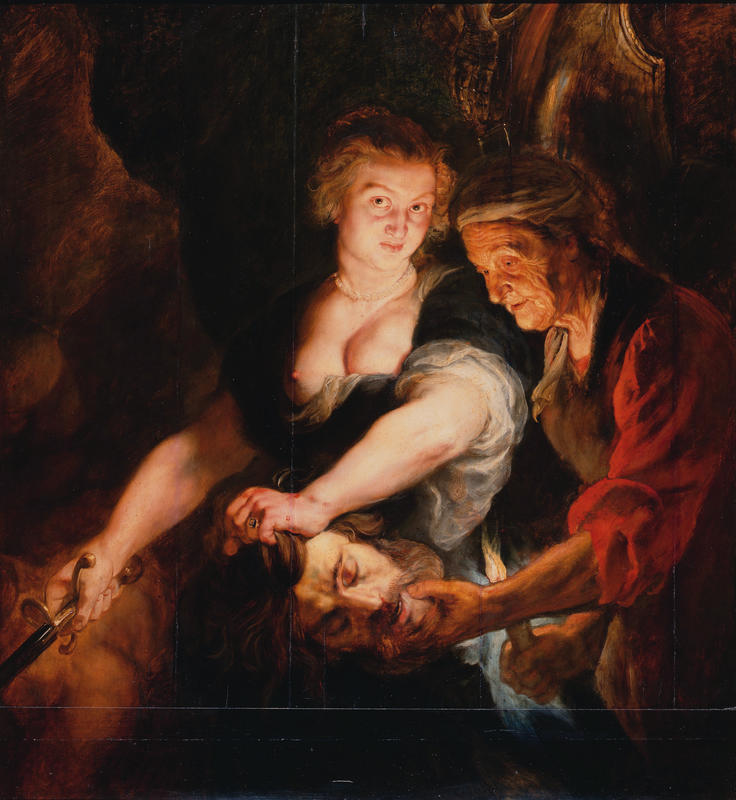More about Judith with the Head of Holofernes

Contributor
Like a Hollywood action movie, Rubens’s Judith with the Head of Holofernes unites violence with sex appeal.
For those unfamiliar with the Old Testament story that Rubens depicts, General Holofernes is laying siege to Bethulia until the widowed Judith and her maid Abra sneak into the enemy’s camp one night. To prevent the local leaders from surrendering to the invaders, Judith trades in her garments of widowhood for her finest attire, accentuates her seductress qualities with her best jewelry, and enters the camp with the intentions of seducing and betraying Holofernes. Charmed by Judith’s appearance, Holofernes grants Judith access to his private tent where they drink together, and Judith coaxes him to drink in excess until he eventually passes out and succumbs to a drunken slumber. With Abra on lookout, Judith seizes this opportunity to behead Holofernes, and save her people.
Rubens illustrates the moment following this symbolic act of castration. The flame from Abra’s candle highlights Judith’s smooth, lily-white face and Abra’s tan and wrinkled complexion. As Abra leans closer to examine the fatal wound, the close proximity of Judith’s and Abra’s faces allow the audience to compare their features. Abra’s darker, more frail, and wrinkled skin serves as a foil to Judith’s bright, plump, and youthful face. Juxtaposed with Abra and the dark night background, Judith’s beauty shines more vibrantly, fixing her position as a seventeenth-century emblem of ideal beauty. With the sole purpose of accentuating Judith’s beauty, Abra’s presence reveals a societal fixation on whiteness and youth as prominent indicators of beauty.
Rubens’ depiction is unique, because he complicates his narrative by painting a wedding band on Judith’s ring finger. As Judith extends her bloodied left hand towards the audience, she is simultaneously displaying Holofernes’ head and her wedding ring. While past depictions of Judith slaying Holofernes leave her ring finger bare to portray Judith’s disguise of unmarried seductress in its entirety, Rubens allows the archetypes of seductress and wife or widow to exist concurrently.
Judith switches from dream lover to especially fatale femme fatale so quickly that the poor girl doesn’t even get the chance to adjust her dress and recover from her nip slip. By painting her in this revealing manner, Rubens’s Judith becomes a seventeenth-century Fighting F*ck Toy (FFT), a term coined by Professor of Politics, Caroline Heldman, to describe hypersexualized female protagonists who kick ass and appear empowered, but function as eye-candy specifically for the straight male viewer. Since she’s wedded to normalized male violence, she can put up a fight, but she is still not safe from the objectifying male gaze.
However, Rubens is not alone in appropriating Judith’s story to restrict women into the confines of either sex object or hag. Rubens’ depiction is only one of many paintings that adhere to the traditional portrayal of Judith and Holofernes. Only a few artists, such as Artemisia Gentileschi, Orazio Gentileschi, Titian, and Hans Cranach the Younger, have rejected these conventions.
Sources
- Heldman, Caroline. “‘The Hunger Games,’ Hollywood, and Fighting Fuck Toys.” Dr. Caroline Heldman. 5 April 2012.
- Heldman, Caroline. Miss Representation. DVD. Directed by Jennifer Siebel Newsom. New York: Virgil Films & Entertainment, 2011.
- Smith, Jack. “After 19 Years, This Badass Heroine is Being Treated like a Piece of Meat.” Mic. 16 June 2015.













